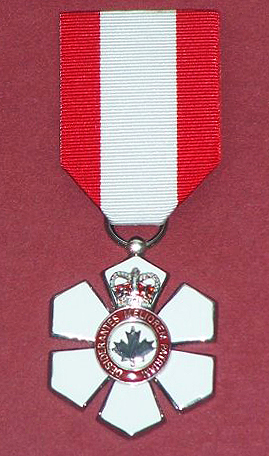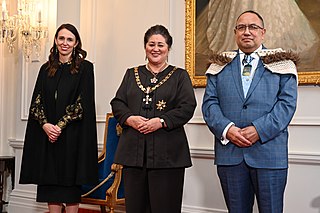
The Order of Canada is a Canadian state order and the second-highest honour for merit in the system of orders, decorations, and medals of Canada, after the Order of Merit.

The Order of Merit is an order of merit for the Commonwealth realms, recognising distinguished service in the armed forces, science, art, literature, or the promotion of culture. Established in 1902 by Edward VII, admission into the order remains the personal gift of its Sovereign—currently Edward VII's great-great-grandson Charles III—and is restricted to a maximum of 24 living recipients from the Commonwealth realms, plus honorary members. While all members are awarded the right to use the post-nominal letters OM and wear the badge of the order, the Order of Merit's precedence among other honours differs between countries.

The New Zealand royal honours system, a system of orders, decorations and medals, recognises achievements of, or service by, New Zealanders or others in connection with New Zealand. Until 1975, New Zealand used the British honours system. Since then the country has introduced a number of uniquely New Zealand honours, and as of 2021, only the dynastic British honours continue in active use in New Zealand, with the exception of the Order of the Companions of Honour.

The New Zealand Order of Merit is an order of merit in the New Zealand royal honours system. It was established by royal warrant on 30 May 1996 by Elizabeth II, Queen of New Zealand, "for those persons who in any field of endeavour, have rendered meritorious service to the Crown and nation or who have become distinguished by their eminence, talents, contributions or other merits", to recognise outstanding service to the Crown and people of New Zealand in a civil or military capacity.

The Order of New Zealand is the highest honour in the New Zealand royal honours system, created "to recognise outstanding service to the Crown and people of New Zealand in a civil or military capacity". It was instituted by royal warrant on 6 February 1987. The order is modelled on the Order of Merit and the Order of the Companions of Honour.

The Royal Victorian Order is a dynastic order of knighthood established in 1896 by Queen Victoria. It recognises distinguished personal service to the monarch, members of the royal family, or to any viceroy or senior representative of the monarch. The present monarch, King Charles III, is the sovereign of the order. The order's motto is Victoria. The order's official day is 20 June. The order's chapel is the Savoy Chapel in London.

Sir Michael Hardie Boys, was a New Zealand lawyer, judge and jurist who served as the 17th Governor-General of New Zealand, in office from 1996 to 2001.

The Order of precedence in New Zealand is a guide to the relative seniority of constitutional office holders and certain others, to be followed, as appropriate at State and official functions. The previous order of precedence was revoked and Queen Elizabeth II approved the following Order of Precedence in New Zealand effective 20 September 2018:
- The Monarch of New Zealand.
- The Governor-General or, while acting in the place of the Governor-General, the officer administering the Government
- The Prime Minister
- The Speaker of the House of Representatives
- The Chief Justice
- The Dean of the Diplomatic Corps
- The Deputy Prime Minister
- Ministers of the Crown
- Former Governors-General
- Ambassadors and High Commissioners in New Zealand and Chargés d’Affaires accredited to New Zealand.
- The Leader of the Opposition in the House of Representatives
- Leaders, including co-leaders and joint leaders, of political parties represented in the House of Representatives, other than Ministers of the Crown.
- Members of the House of Representatives. There is no established order of precedence over members of parliament in general, although each party has its internal ranking.
- Judges of the Supreme Court of New Zealand, the Court of Appeal and the High Court of New Zealand.
- Former Prime Ministers, former Speakers of the House of Representatives, former Chief Justices, and members of the Privy Council.
- Mayors of territorial authorities and chairpersons of regional councils, while in their own cities, districts and regions. In 1989, boroughs and counties were amalgamated into district councils. District mayors, and the Chatham Islands mayor could expect to be accorded this same precedence.
- The Public Service Commissioner, Chief of Defence Force, Commissioner of Police, and Officers of Parliament .
- The Solicitor-General, Clerk of the House of Representatives, and Clerk of the Executive Council when attending a function involving the exercise of the position’s specific responsibilities.
- Chief executives of public service and non-public service departments.
- The Vice Chief of Defence Force, and Chiefs of Navy, Army and Air Force, and other statutory office holders.
- Consuls-General and Consuls of countries without diplomatic representation in New Zealand.
- Members of New Zealand and British orders, and holders of decorations and medals in accordance with the Order of Wear in New Zealand.
The orders, decorations, and medals of Canada comprise a complex system by which Canadians are honoured by the country's sovereign for actions or deeds that benefit their community or the country at large. Modelled on its British predecessor, the structure originated in the 1930s, but began to come to full fruition at the time of Canada's centennial in 1967, with the establishment of the Order of Canada, and has since grown in both size and scope to include dynastic and national orders, state, civil, and military decorations; and various campaign medals. The monarch in right of each Canadian province also issues distinct orders and medals to honour residents for work performed in just their province. The provincial honours, as with some of their national counterparts, grant the use of post-nominal letters and or supporters and other devices to be used on personal coats of arms.
The Royal Victorian Medal (RVM) is a decoration established by Queen Victoria in April 1896. A part of the Royal Victorian Order, it is a reward for personal service to the Sovereign or the royal family, and is the personal gift of the Sovereign. It differs from other grades of the order in appearance and in the way it is worn.

Lieutenant General Sir Jeremiah Mateparae is a former New Zealand soldier who served as the 20th governor-general of New Zealand between 2011 and 2016, the second Māori person to hold the office, after Sir Paul Reeves. A former officer in the New Zealand Army, he was the Chief of the Defence Force from 2006 to 2011, and then served as the director of the New Zealand Government Communications Security Bureau for five months in 2011. Following his term as governor-general, Mateparae was the high commissioner of New Zealand to the United Kingdom between 2017 and 2020.

Sir Anand Satyanand, is a New Zealand former lawyer, judge and ombudsman who served as the 19th Governor-General of New Zealand from 2006 to 2011.
The order of wear for decorations and awards within New Zealand's honours system is published by the Department of the Prime Minister and Cabinet.

The Order of Military Merit is a military honour for merit that is, within the Canadian system of honours, the second highest order administered by the Governor in Council on behalf of the Canadian monarch.
The New Zealand Armed Forces Award is a long service decoration for Regular Force Officers of the New Zealand Defence Force. Established on 6 May 1985, the medal was originally presented for 15 years of unblemished service. On 14 August 2020, a new gazette was issued with modified criteria for the medal to be awarded for 14 years of service. Clasp eligibility was reduced from 15 years to seven years.

Dame Alcyion Cynthia Kiro is a New Zealand public-health academic, administrator, and advocate, who has been serving as the 22nd governor-general of New Zealand since 21 October 2021. Kiro is the first Māori woman and the third person of Māori descent to hold the office.

Dame Patricia Lee Reddy is a New Zealand lawyer and businesswoman who served as the 21st governor-general of New Zealand from 2016 to 2021.
The 2011 Special Honours in New Zealand were two Special Honours Lists, published in New Zealand on 20 May and 17 August 2011. Appointments were made to the New Zealand Order of Merit and the Queen's Service Order to recognise the incoming governor-general, Jerry Mateparae, and the outgoing vice-regal consort, Susan, Lady Satyanand.

Peter John Cartwright was a New Zealand lawyer and, as the husband of Dame Silvia Cartwright, viceregal consort of New Zealand between 2001 and 2006.
The 2001 Special Honours in New Zealand were two Special Honours Lists, published in New Zealand on 20 and 21 March 2001. Appointments were made to the New Zealand Order of Merit and the Queen's Service Order to recognise the incoming governor-general, Dame Silvia Cartwright, and the outgoing governor general and viceregal consort, Sir Michael and Lady Hardie Boys.
















